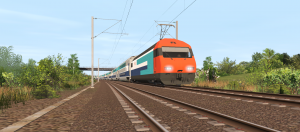
DOWNLOAD (both KCR and MTR versions are included)
All the necessary dependencies are either included in the package or are avaible on the DLS. Dependencies that are not mine are property of their respective authors.
In preparation for the electrification of the “Chinese section” of the Kowloon-Canton Railway (between the Hong Kong border crossing at Lo Wu and Guangzhou), KCR placed an order for a dedicated electric trainset for use on the “Kowloon Trough Train” services, non-stop expresses running between Hong Kong and Guangzhou. These trough-trains had been operated jointly since the 1980 by the KCR (hauled by G12, G16 and G26 diesel locomotives) and the Chinese Railways (hauled by DF3, DF4 and later DF11 diesel locomotives), using the latter’s 25T-type coaches.
However, ever since the electrification of the Hong-Kong section of the line in 1983, plans were drawn for an eventual electrification of trough-trains as well. Eventually, by the mid-1990s, the Chinese Railways started electrifying their section of the line. In preparation for this, in 1995 KCR ordered two “Lok 2000” type electric locomotives from ABB and AdTrainz and twelve stainless-steel double-decker passenger coaches from Kinki-Sharyo: 10 “first class” one and two “executive class” ones.
Original plans called for a purchase of an EMU-type of train, however the KCR settled for a locomotive-hauled train for the sake of maximium flexibility. The trainset, to be named KTT (“Kowloon Trough Train”) was still intended to function as an EMU, with the two electric locomotives being fitted at each end of the train, push-pulling a variable number of intermediate coaches.
The two “Lok 2000” electric locomotives, classified as “TLN001” and “TLS002” (with the “N” or “S” referring to the geographical “side” of the locomotives when copuled with the train: North towards Guangzhou or South towards Hong Kong) were derived from the very successful Re 460 family of locomotives of the swiss federal railways, the SBB CFF FFS, however they fetaured upgraded electronics and were more powerful, effectively making them similar to the Re 465s of BLS. Unlike their european counterparts, the KCR Lok 2000s were fitted with american-style knucle-copulers, of the same type used both by KCR and by the Chinese Railways. Finally, the two locomotives were mono-voltage ones (using 25Kv AC 50Hz catenary, the same system used in both Hong Kong and China) and were officially rated for a maximium speed of 230Km/h.
The two KTT Lok 2000s fetaure an interesting asymmetric livery, with one side having red fronts and the other being white and dark-blue: the former is intended to be the proper “front” of the KTT train, while the latter is intended to be the side of the locomotive to be coupled to the passenger coaches (wich fetaure a matching livery). Both cab sides are howere still functional and it isn’t uncommon to see one, or both locomotives running “blue-white front” first, with the red side coupled to the coaches.
The two locomotives arrived in Hong Kong from Switzerland on the 11th of May 1997, with the 12 double-decker coaches being delivered from the Japanese Kinki Sharyo shortly after. However, since the electrification on the Chinese Section of the Kowloon-Canton line wasn’t completed yet, the KTT train was briefly stored at KCR’s Ho Tung Lau depot before being put in service as a temporary non-stop express train between Hung Hom and Lo Wu starting from the 24th of January 1998.
Electrifications works on the Chinese Section of the line were eventually completed in May 1998, with the KTT finally beginning regular Hong Kong-Guangzhou direct services on the 28th of May, running between Hung Hom station in Hong Kong and Guangzhou East station in mainland China. In 2007, with the merger of KCR into MTR, the KTT set passed under the ownership of the latter, retaining the same livery but with changed logos.
Currently, the KTT operates daily between Hong Kong and Guangzhou in a variable formation (depending on the demand) between seven and ten cars in lenght (two of wich are always “executive class” coaches), sandwiched between the two Lok 2000s. However, since the opening of the slightly faster high-speed Express Rail Link in 2018, the position of the KTT has been in jeopardy, as a ceasation of services, freeing much needed space for commuter trains on the East Rail line, seems a very likely option.
Until then, the KTT will continue running on the Kowloon-Canton Railway, shuttling passengers between Hong Kong and Guangzhou.
Trivia:
KCR’s two Lok 2000-type electric locomotives are notable for several reasons: they are Hong Kong’s first (and with all due probability last) mainline electric locomotives, the first VVVF-inverter controlled items of rolling stock of Hong Kong (both of the MTR and the KCR network) and also the first 200+Km/h-capable railway vehicles in regular service, both in Hong Kong and in mainland china.
They’re also the very last items of rolling stock to have “set foot” on British Hong Kong, a mere two months before the 1997 handover to China of the 1st of July.
